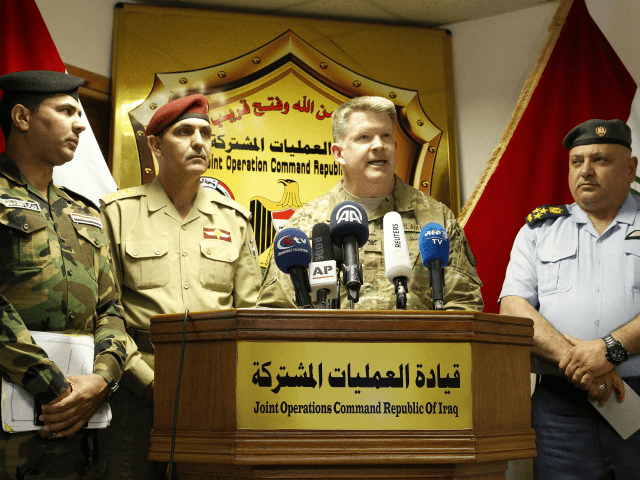The U.S. military in Iraq is downsizing its headquarters staff, as its mission shifts away from supporting Iraqi troops in combat.
Combined Joint Task Force – Operation Inherent Resolve spokesman Army Col. Thomas Veale told Breitbart News on Monday the move “will create efficiencies and enable the command to eliminate some duplicative staff positions and functions.”
“What’s most important is that we have no more troops than we need; and when we’re done, we’ll take them out of the theater,” he said. He did not say how many, or which, positions would be eliminated.
There are about 5,200 U.S. troops in Iraq, according to the Pentagon. That number is slightly down from the 5,262 acknowledged in December, but counting troops is often a futile exercise since troop numbers fluctuate as forces flow in and out of theatre for various reasons.
Still, the downsizing indicates less of a need for U.S. support for ground combat operations in Iraq, as the mission moves towards training Iraqi forces.
Specifically, the staff of Combined Joint Forces Land Component Command – Operation Inherent Resolve (CJFLCC-OIR), the component in charge of land operations in Iraq, will be consolidated into the overarching Combined Joint Task Force – Operation Inherent Resolve (CJTF-OIR), the task force in charge of military operations in Iraq and Syria.
CJFLCC-OIR’s Twitter feed is populated with photos of U.S. and coalition forces training Iraqi forces.
U.S. commanders previewed this downsizing in briefings with Breitbart News and three other news organizations in December at a military base in Southwest Asia. They said the number of U.S. troops in Iraq and Syria will go down in response to the recent defeat of the Islamic State.
U.S.-backed Iraqi forces retook Mosul, ISIS’s last major stronghold in Iraq last July, and U.S.-backed Syrian Kurdish forces retook Raqqa, the group’s de facto capital in Syria, last September. Overall, U.S.-backed forces in Iraq and Syria have retaken 98% of territory controlled by ISIS at its peak. The remaining two percent are mostly in the Middle Euphrates River Valley in Syria.
The number of coalition airstrikes in Iraq have gone down dramatically from one year ago. Last week, there were 15 airstrikes in Iraq. One year ago during the same period, there were 81 airstrikes.
The consolidation in Iraq was announced as the 10th Mountain Division, from Fort Drum, New York arrived in Baghdad to take over command of CJFLCC-OIR from the 1st Armored Division from Fort Bliss, Texas.
The U.S. military indicated that the reduction was also requested by the Iraqi government.
“The transfer of authority between 1st Armored Division and 10th Mountain Division is part of a headquarters consolidation within Combined Joint Task Force – Operation Inherent Resolve, representing another step forward in reducing U.S. troop levels in accordance with the request of the Government of Iraq,” a press release on the transfer said.
Army Maj. Gen. Walter E. Piatt, commander of the 10th Mountain Division, took command of CJFLCC-OIR from Maj. Gen. Robert P. White, commander of the 1st Armored Division.
CJTF-OIR commander Lt. Gen. Paul E. Funk II praised the 1st Armored Division during a change of command ceremony in Baghdad.
“The Iron Soldiers saw the end of the tough fight to seize the crown jewel of ISIS’ so-called caliphate in Mosul,” he said. “Life is beginning to stabilize in liberated areas, but the battle against this barbaric enemy is not over.”
“CJFLCC’s mission continues to support training, advising and equipping Iraq’s security forces to achieve the lasting defeat of Daesh and help provide security to the people of Iraq. “We are deeply honored to take our place in this Coalition,” said Piatt.

COMMENTS
Please let us know if you're having issues with commenting.